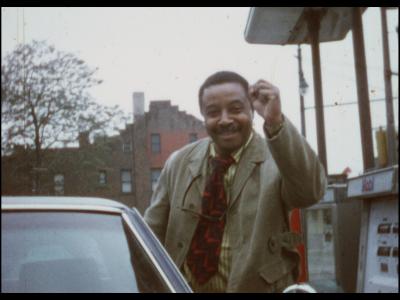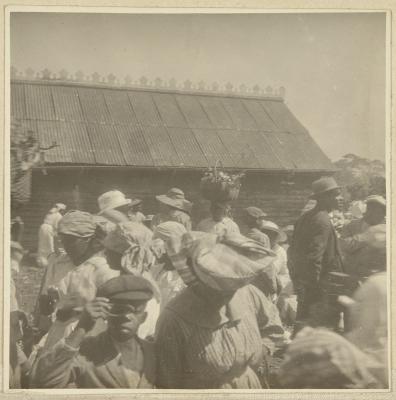Rick Prelinger on home movies
Prelinger is an archivist, writer, filmmaker, scholar and consulting curator of I AM HERE.
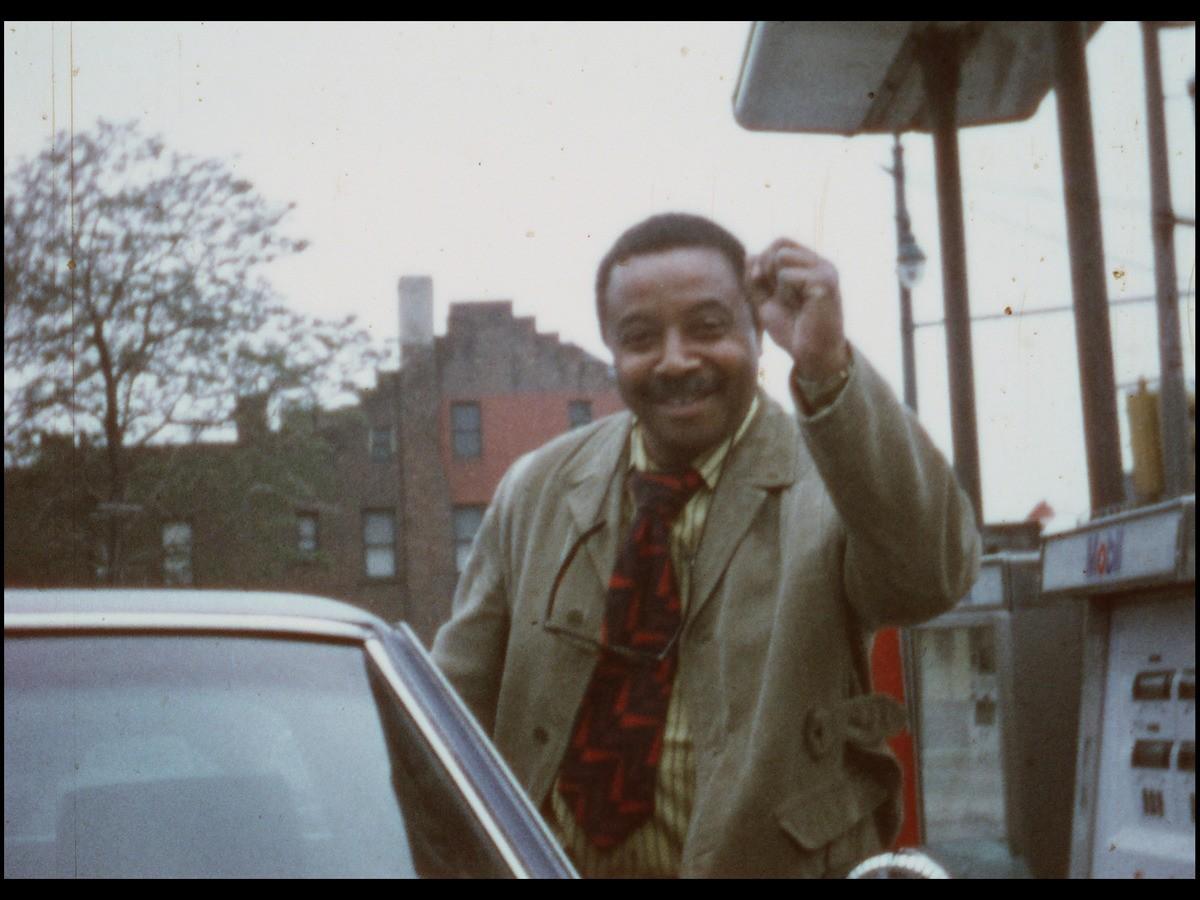
Rick Prelinger, Home movies of the home: Black Man Fist Salute at Detroit Gas Station (1971–72), 2020. Film still courtesy of Prelinger Archives.
I AM HERE: Home Movies and Everyday Masterpieces [closed at the AGO August 2022] is a supercharged celebration of the human impulse to record daily life, expressed through a range of media, including paintings, photographs, drawings, personal collections, time capsules and more. Home movies are integral to the exhibition, with selections from the Prelinger Archives featured throughout and prominently in the video installation PANORAMA (2022).
For a deeper understanding of the importance of home movies, we’re sharing an essay by Rick Prelinger, archivist, writer, filmmaker and scholar. With Prelinger as consulting curator, I AM HERE is co-curated by Jim Shedden, AGO Manager of Publishing, with Alexa Greist, AGO Associate Curator and R. Fraser Elliott Chair, Prints & Drawings. Pick up your copy of the exhibition catalogue, which features Prelinger’s essay along with over 500 images and much more, at shopAGO, online or in-person. You can also check out Prelinger’s AGO Talk if you haven’t already.
Home Movies
By Rick Prelinger
Before cell phones, digital cameras, camcorders, or Polaroids, even before video’s glowing rectangle faded up from black; before TikTok, Instagram, Vine, selfies, texting, sexting, and Zoom; and very long before we began making media to beam to our BFFs across the table, there were home movies. Many are gone, but many millions of films and videos remain, each a pixel in a giant collective documentary spanning almost a hundred years.
Home movies belong to us. Our lives fill every frame. While Hollywood crews shot big-screen films featuring big-name actors, home-movie makers aimed their small cameras at family, friends, strangers, and only sometimes celebrities. We toted cameras on trips, propped up babies to pose, panned to follow teenagers’ awkward dances and triumphant graduations. No twentieth-century celebration lacked a camera; an imaginary archive of all home movies ever made would hold hundreds of millions of weddings, Christmases, Hanukkahs, and Kwanzaas; birthdays from zero to over a hundred; and even a few (though not many) funerals. No everyday moment escaped the home-movie maker’s gaze. Washing dishes, fixing the car, hanging laundry, leaving work, boarding the school bus, riding the train, fishing (lots of fishing), living in the eternal suburban present—these small events and more make home movies an infinite record of common memories. Filled with beauty, affection, chance, and error, home movies are found art, running the gamut from masterpiece to missed opportunity. And every home movie is a stake in the ground, a monument of stone, a newly planted tree; in short, a gesture of permanence: I, you, we are here.
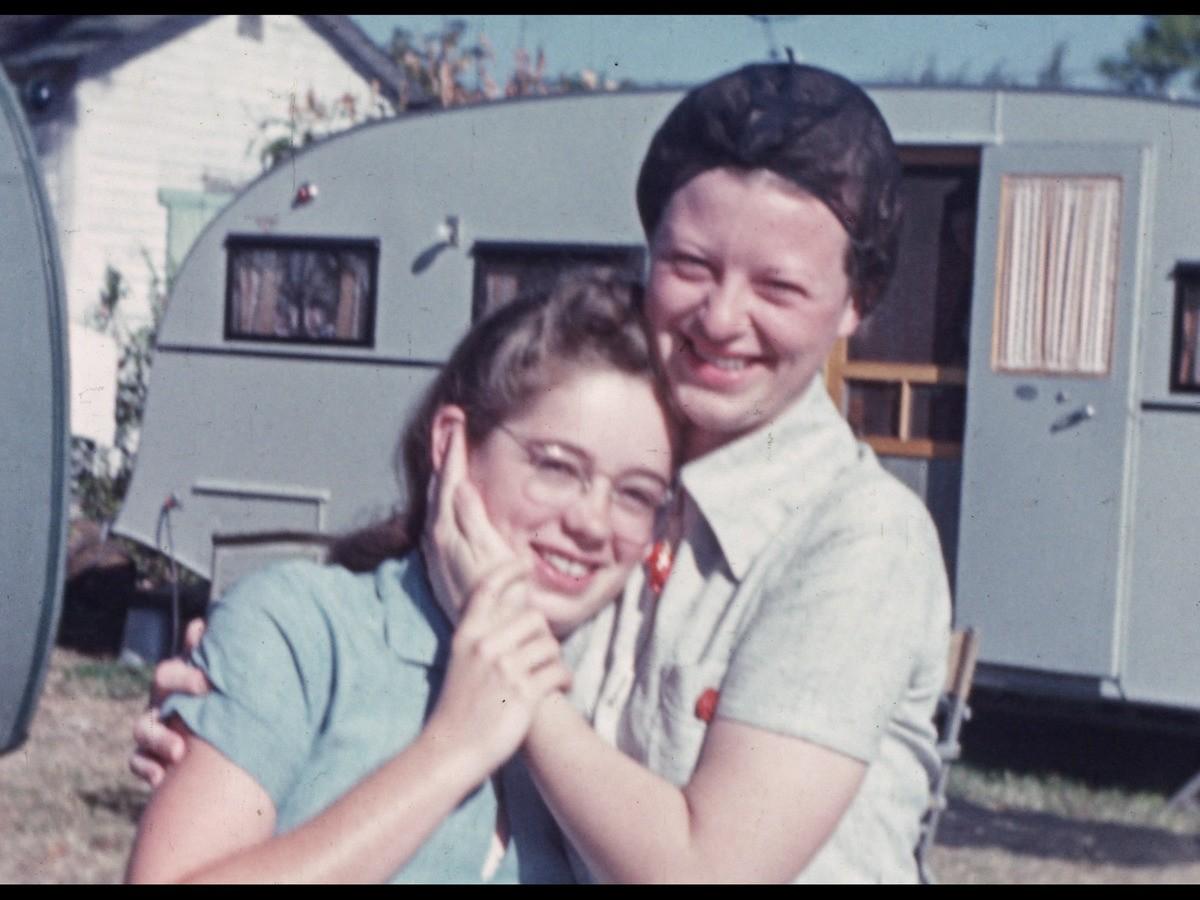
Rick Prelinger, Home movies of the home: Woman Hugging Woman (c. 1940), 2020. Film still courtesy of Prelinger Archives.
The peculiar charisma of home movies arises out of their ability to combine both fixed and floating meanings. What other kind of routine record evokes such an emotional response when projected on a big screen? And what other kinds of records are at once so realistic yet so enigmatic? While they share an essential characteristic with cinema—both inscribed in film—they have little to do with what we normally think of as “movies.” Home movies reduce the great narratives and conflicts of the twentieth century to a personal point of view while at the same time elevating the small moments of daily life to a grand scale. Rich histories play out in home movies, even though they show relatively few actual historical events. Stealthily but strikingly, they offer intimate views of the familiar while at the same time making the familiar strange. Recording vividly and ennobling quietly, home movies make art from the everyday and make the everyday into art.
That said, everyday history is neither quiet nor peaceful. Whether by conclusion or omission, home movies are contentious documents in a memoryscape where the legacies of conquest, division, and privilege are explicitly or implicitly visible in every frame. The history of whiteness in the twentieth century is written into a large portion of home movies, and to watch home movies en masse is to experience an exhausting archive of whiteness that’s generally unaware of its history and entitlement. For most of us, our pride of place rests on settler colonialism—the displacement of Indigenous peoples and occupation of their lands by a society of settlers—just as the paths of our road trips follow in and deepen the trails of Manifest Destiny. Racialized and gendered power enables the home movie gaze, but this is not to say that there aren’t alternate pasts and futures. Home movies are full of histories of resistance and survival, especially among the underrepresented: communities of colour as well as nonbinary and gender-nonconforming people. The evidence in home movies is deep enough to help us reconsider both good and bad in the past, and to point toward ways in which we might imagine and begin to build reparative landscapes. In this and in other ways, home movies point to the future through the past.
Once There Were Home Movies
The home movie impulse is as old as cinema itself. We might think of the Lumiere brothers’ first film (Sortie des Usines Lumière à Lyon/Workers Leaving the Lumière Factory, shot and shown in 1895) as a mashup of two genres: an industrial film crossed with a home movie of the family business, boasting how many workers they employed. Excited by their new ability to reproduce and contain their worlds on film, early filmmakers often pointed cameras at friends and family. However, the traces that survive from the first quarter-century of home-movie making reveal a rarefied world inhabited almost exclusively by wealthy people who could afford to hire experienced camera people to film mostly formalized activities. Houses, horses, and hirelings surround captains of finance and industry as they share moments of leisure with their families.
Like the late nineteenth-century box camera and the smartphone in the 2010s, home movies eventually democratized. In 1923, Eastman Kodak introduced 16mm film, a non-combustible and less expensive alternative to the 35mm theatrical standard. But buying a camera and projector was no small commitment: the first outfit cost $325 (USD), equivalent to about $4,900 (USD) today. The price of a single hour of film and processing was about $89 ($1,350 today), about two weeks’ pay for a union carpenter in a large city. It’s no surprise that home movies of the 1920s and early 1930s continued to centre on the activities of the comfortable, though not all 16mm film showed the gentry; some movies visited humbler environments and featured people of colour or scenes in the homes of working families. In anticipation of what would become the transgressive selfie, there was abundant footage of drinking during Prohibition. Period advertising demonstrates how home-movie equipment and film were marketed to women, a hint at how central women’s involvement as shooters, editors, and projectionists would be to home-movie culture. Home-movie making quickly spread throughout the world, usually following wealth but also often focusing on so-called “primitive” peoples and “picturesque” landscapes of poverty. Organizations of non-Hollywood makers—notably the Amateur Cinema League—sprang up to promote the making of “amateur films,” which distinguished themselves from home movies by a concern for storytelling and technical virtuosity.
When the Great Depression weakened the market for luxury goods, Kodak slashed the cost of 16mm film in half to create a much less expensive alternative: 8mm, introduced in 1932. This brought the cost of a camera and projector down to $52 (USD) ($980 today) and the cost of a three-minute roll of film to $2.50 (about $47 today). Small-gauge film (8mm and 16mm) enabled personal movie making to bloom almost everywhere. Families of colour, working-class people, farmers and rural Americans, and children all became home-movie makers. The introduction of Kodachrome film followed in 1935, offering beautiful, hyper-realistic images at relatively low cost. Surviving early 8mm films offer a vivid look into society and landscape before World War II. World’s fairs, the migrant workers also seen in The Grapes of Wrath, New Deal public works projects, street scenes in every city and town—what these images lack in resolution, they make up for in diversity of topic. The advent of 8mm brought us closer (at least, in North America) toward an era of complete documentation, where every kind of human interaction, activity, exchange, and foible might possibly be filmed by someone, sometime, somewhere. As the once-tight link between amateur filmmaking and wealth was broken, a deep home-movie history of daily life began to accumulate.
Small-gauge film came of age during World War II, when military camera operators formally and informally filmed the war. 16mm, which had slowly become the platform upon which a small but growing industrial and educational film industry relied, found extensive use in military training. Thousands learned filmmaking skills while serving in the war and afterward started production companies to make films for classrooms and corporations. Many who shot film as an occupation also shot it as a hobby, and many home-movie makers exposed film in war-surplus cameras and screened it with surplus projectors. With the growth of a relatively comfortable North American middle class, home movies went mainstream. A large consumer movie industry evolved.
Manufacturers rushed to monetize home-movie fascination. Soon after widescreen movies entered theatres, widescreen lenses hit the home-movie market but achieved little success. In 1965, Kodak tried to narrow the distinction between amateur and professional with the introduction of a new format: Super 8. With smaller perforations, the Super 8 picture area was considerably larger than that of standard 8mm and allowed space for a thin magnetic sound strip, making sound accessible to many amateurs who had not been able to afford the expensive systems available since the 1930s. Immensely popular in the marketplace, Super 8 used easy-to-load cartridges and, like Kodak’s Instamatic still camera introduced two years earlier, was a “friendly” format designed to encourage film consumption, especially by women and children. Home movies flourished, with many hundreds of models of cameras and projectors becoming available worldwide.
But as personal media platforms proliferated, home-movie making became paradoxically less popular, for reasons not completely understood. While movies had to be dropped off at a camera shop or mailed to a lab for processing, late-1970s “mini labs” turned around snapshots in one hour, and Polaroid cameras offered instant gratification. Perhaps people grew tired of the intricate and complex workflow of filmmaking that included lighting, rewinding, splicing, and projecting. Even though home video reached just 1 percent of American homes in 1980 and still only 10 percent in 1984, the homemovie business had already begun to wane in the mid-1970s, and by the 1980s far fewer families used film. If people pulled their yellow cardboard boxes and metal tins of home movies out of closets, most often the reason was to send them to a transfer house where semi-skilled technicians made VHS or DVD copies. Sadly, many junked their films after receiving these relatively low-resolution videos, not realizing that film would have lasted longer than ephemeral video formats. Today, high-quality film scanning is more affordable and people are slowly realizing the benefit of holding on to their celluloid originals.
Video may be less durable than film, but that’s not stopped its march toward infinity. Originally shot in VHS and other consumer formats—now mostly digital video shot by the smartphones we all carry—home video has moved the world toward the Borgesian 1:1 document-to-life ratio. Freed from film’s expense and the constraints of the three-minute reel, video flows without interruption from phones, webcams and webcasts, surveillance cameras, and even the short-lived but significant Google Glass, one of the first attempts to integrate video recording and playback with the human body. For many kinds of human activity, not generating video is actually the exception. The aesthetics of home video take us far away from the more formalized look of home movies (and the staccato brevity determined by film’s expense), and most of us now shoot video for different reasons than people once shot film. If home-movie makers shot to remember moments so they would not slip from memory, video makers today shoot to create the moment itself. The relation between what we experience as “life” and its record is fading away. We don’t shoot to document relationships or activities—we shoot to perform them. Video isn’t like writing; rather, it’s like speech. And until it becomes unforgivably gauche (if it ever does) to make shooting and playback part of our social lives, we will be working at new and ever-more sophisticated ways of living our lives through image-making.
Even though the interval between the end of home-movie making and the onset of ubiquitous video was brief, and even though home movies and home video share commonalities of expression, the divide between home movies and home video is immense. If homemovies-on-film still have jobs to do (and I am convinced that they do), one of their major uses may be to enable the kind of distanced gaze in which seeing the way we used to see helps us to understand the way we make and see images now. The slower and more deliberate pace of many home movies increases our consciousness of today’s frenetic and infinite image-making practices, and allows us to possibly imagine a decelerated future gaze.
Today, home movies and home videos function as both time capsule and time machine. Film and television producers crave their authenticity, freshness, and spontaneity, so much so that they often use digital tricks to fake “home-movieness.” Documentary researchers covet films in which personal filmmakers witnessed history or filmed celebrities. Artists and filmmakers are drawn to their enigmatic nature and to the vast primary evidence they contain, uncorrupted by digital enhancement or commentary. Members of marginalized communities find otherwise-untold stories in everyday documents. Home movies are integral parts of local history presentations and are analyzed by researchers looking to understand changes in the contours of urban life and infrastructure. Individual collectors and a growing number of regional archives around the world have built significant holdings of home movies and amateur film. As stated on its website, the non-profit Center for Home Movies seeks “to transform the way people think about home movies by providing the means to discover, celebrate, and preserve them as cultural heritage.” Beginning in 2003, the centre’s founders organized a worldwide series of Home Movie Days to rediscover and mainstream home movies at a local level: in 2019, there were seventy-six Home Movie Days in twenty-two countries.
The question, of course, is whether home movies and “home-movieness” are current fads of this hyper-image-conscious era, or whether consciousness of their value and the development of new kinds of reuse will continue to escalate. I’m certain that it will. Almost two hundred years of photography and the turn toward an infinitude of digital imaging have not lessened our collective fascination with the still image, and I would argue that most people are just beginning to come to terms with personal filmmaking. Deeply appreciating home movies requires the same kind of contemplative attention (or, alternatively, active and loud spectatorship) that one devotes to other time-based work, which for some people creates a barrier to attention no matter how much contemplation might reward the spectator. Home movies thankfully haven’t yet reached the intense level of trading and commodification that we’ve seen with vernacular photography and snapshots, but it is likely they will, as more connoisseurs come to understand the uncanny amalgam of evidence, poetry, and chance that’s manifested in them.
The Ritual
It happened sometimes in the living room, sometimes in the basement rec room, occasionally at a relative’s house. Someone lifted the projector, often quite heavy for its size, from its intricately packed box. You swung up and out to extend the arms that held the reels. You felt the metal-on-metal scraping in your bones as you pulled up the screen and hooked it onto the tripod. You pulled a length of film off the supply reel and carefully loaded the projector so the film wouldn’t tear. You turned the projector on and, as it chattered to life, you smelled the controlled burn of the lamp. You focused (why did you always have to focus?) and then you were free to join the others and watch the film. (If the film broke, you stopped the projector and quickly taped it back together.) And when the film was done, you rewound and took the screen and projector apart again…. It was this way in millions of homes throughout the developed world for half a century.
A Very Particular Record
Life fits snugly into a glowing rectangle. Or does it?
The social, cultural, and visual codes that underlie our behaviour are vividly revealed in home movies. Blowing out birthday candles? Struggling to keep a hula hoop spinning? Driving with an open container? Any home-movie archives can lead you into a vortex of familiar memes. Abundant repetition reveals more about holiday rituals than any individual record can. But we live for the curveballs, the deviations from the norm: the uncle lying in his coffin surrounded by his family eating a meal; Dad trying to hold all five kittens in his arms at once; mother and daughter making a mixtape in the 1950s. These are the films you want to view again and again. Their ethnographic interest (and charm) rests in the tension between predictability and surprise, in the possibility that anything could happen or that small details could inject a boring film with a sense of revelation.
Once again, defamiliarization is key. Home movies render the familiar, the unconsidered, the everyday, strange; or if not always strange, something worthy of close observation. The very presence of the everyday on-screen moves it from its ordinariness into a place of privilege where it asks for attention that we unreservedly grant—akin, maybe, to how we address a painting hanging on a museum wall, and even more true when we blow up a home movie to big-screen size. We are likely to carefully study in a home movie what we are least likely to consider in our own lives. Just as watching someone try to tie a knot, unlock a stiff door, or start a stalled car awakens an irrepressible urge to jump in and do it ourselves, seeing home movies triggers self-reflection, empathy (or its opposite), or thoughtfulness. We observe others and rethink ourselves.
Primal emotions animate home movies. Most films are clearly motivated by attraction; by love for people, places, hobbies, or moments. Fewer home movies picture the unloved and disliked, but at the same time home movies are full of anger and aggression. We see countless examples of in-your-face camerawork, family members ambushed by bright lights, intrusions upon others’ rights to be left alone. Men, especially, commit symbolic and actual violent acts against women and force children to perform in front of the camera. The visual record of many households is full of bearhugs, ambushes, unwanted kisses, grabbing, ogling, wrestling, and tickling.
Regardless, there is a strong argument that home movies are in large part a women’s medium. At times there are upfront clues: byplay between spouses or partners where it’s clear the woman is behind the camera. Other times the clues are subtler: scene logs demonstrably written by women tucked into film cans; hints of women’s sensibilities guiding edits of raw footage into tighter and more coherent compilations, sometimes even turning footage into narrative; a balance between scenes of men and scenes of women.
We may think we are sure of the gender of the shooter when suddenly we’re taken by surprise. In addition, a long, mostly private, tradition of lesbian-made home movies is beginning to breach the obscurity of the closet. Should we attribute authorship solely to the person who is operating the camera, or is it a function not only of shooting but also of editing, description, and collection maintenance? More research may establish that women made a place for themselves in home-movie making when the industry largely rejected their talents.
Survival, Resistance, and Repair
Like all media, home movies express the disproportionate cultural power and privilege held by white Americans. But home movies are also a reservoir of eloquent evidence and self-expression arising from communities of colour, revealing images of survival and resistance as well as celebration and joy. As access to 16mm and 8mm film increased, African Americans shot home movies that powerfully depicted life and community in spite of Jim Crow. Nearly a century later, while still a student at New York University in 2014, Jasmyn Castro began assembling the African American Home Movie Archive, pointing to collections held in institutions across North America. Soon afterward, the Smithsonian’s National Museum of African American History & Culture began The Great Migration Home Movie Project, which partners with people and organizations to digitize home movies and make them accessible. Chicago’s South Side Home Movie Project collects, preserves, and exhibits films made in this prominent Black community. These and other projects sensitized many Americans to the depth and diversity of the BIPOC homemovie record, and they are just beginning. Several archives are also working to collect and offer access to the rich vein of LGBTQ2+ home movies, many of which depict celebration and community in the closeted era. San Francisco’s Center for Asian American Media (CAAM) runs the Memories to Light project, collecting, digitizing, and sharing the full spectrum of Asian-American personal moving-image media, and commissioning artists to make personal films using the collections. Surprising and counter-stereotypical films regularly surface: for instance, a Mexican farmworker family in California’s Central Valley shot Super 8 home movies of themselves while they were harvesting vegetables in the field during the 1970s.
Like other artworks, home movies often present a figure and ground, and the borders of home movies don’t always stop at the edges of the frame. In the foreground, the quotidian: families, homes, leisure, or animals. In the background, the macro: history (wars, depressions, migrations), the militarized West, the petroleum economy, and international borders that were once easy to cross. Situating people and their daily lives against these backdrops, home movies turn them into historical beings, no matter how individual or isolated a single person or family may appear to be; in this way, individual experience is transformed into something collective. Home movies also reveal and document the relationship between nature and culture, which in the twentieth century is most often a divide. Constant coverage of floods, tornado and hurricane damage, and blizzards sensationalize the divide, and there is also fascination with large-scale human projects that modify the behaviour of our planet: dams and artificial lakes, freeways, mines, and timber harvesting. As we return to home movies to rediscover cityscapes destroyed by gentrification and redevelopment, and farmlands captured to build suburbs, we will also find evidence showing the slowly developing consequences of climate change. What appears to be casual evidence of place at the periphery of family films may ultimately become very valuable aids in landscape repair.
Evidence and ambiguity: two values that co-exist in home movies. Home movies revel in ambiguity. Often they preserve the tremors of the shooter’s hand more clearly than they capture what’s supposed to be in front of the lens. Time and again, as we watch, we encounter small dramas lacking beginning, middle, or end; events without cause or consequence; action that might leave the frame or never even enter it; unexplained appearances and disappearances; or images we cannot tie to a specific place or time. Who is this person? Are these two a couple? Which child will live longest? In which house, on which street, in which town, do these people live? And, of course, what don’t we see? Who and what is missing? The unknown is as much of a trigger as the known.
No matter how enigmatic in detail or humble in origin, home movies are always privileged evidence. They are embedded in and inseparable from the cultures that birth them. As complex objects, they record histories and generate meanings in ways that scholars are only beginning to understand and makers only beginning to exploit. They hold the potential to inform research in almost any area: for geographers, changing landscapes; for biologists, species migration and change; for cultural and social historians, the look of work and leisure; for gender scholars, changes in the way gender has been performed; for material culture scholars, the objects of daily use; for ethnographers, dramatizations of kinship and hierarchy; for sociologists, evolving ideas of childhood and adolescence. Gerontologists are now using home movies as anchors for people with memory difficulties.
With that said, home movies are often sensitive documents. Issues of cultural sovereignty, privacy, and opacity surround films shot in many communities, especially those shot by outsiders. Do images depicting traditional knowledge and traditional cultural expression belong to those who shot or possess them, or to the communities they show? Should Indigenous peoples control the dissemination of images made in their communities, whether or not they control physical materials and copyright? Is the condition in which many BIPOC home movies are held in white-controlled archives a reflection of racialized power relations, and how can we restore historical documents to the communities they document and concern? Should we refrain from showing images that trigger trauma and pain? Of what use are home movies depicting the white gaze, the traveller’s gaze, or the ethnographic gaze directed toward communities of colour? While these may be images that disrespect and demean, they may also testify to a history of survival and resistance. How might this material be productively seen and used, and by whom? How should we weigh the value of open access to archival materials in relation to questions of sensitivity, sovereignty, and respect? While the descendants and beneficiaries of settler colonialists and territorial occupiers may experience these dilemmas as new, they are nothing new to communities whose expropriated images have not been used in their favour. Each of these questions demands negotiation between parties who have rarely, if ever, sat across a table to discuss images and their power, and these negotiations have barely begun.
Cinema?
Perhaps the discipline that still hasn’t yet fully engaged with the potential of home movies is cinema studies, where powerful and often reductive notions of “cinema” leave little room to think about the anarchy of personal moving-image expression. Home movies aren’t necessarily part of cinema—they just happen to be shot on film. Many words have been devoted to the question of how home movies represent reality, akin to the long-lasting debates about documentary truth and verisimilitude. But while cinema and media studies have built rich bodies of theory and ideas around many genres of film, they have only begun to take us down the road of understanding home movies. We might address this dilemma by thinking about what’s in home movies and what kinds of toolboxes we might pick from to better understand what goes on in home movies—or, more precisely, what kinds of meaning we can wring from their richness.
Cinema or not, home movies are documentary at their core. I assert this knowing that they’ve lurked around the edges of documentary thinking without being considered seriously. It would be a great mistake to exclude personal documentation from the history of documentary expression in all media; just to name one example; the relationship between home movies and the documentary movements of the 1930s Depression remains to be teased out. If we are to counterpose fine art focused on everyday life with personal documentation of life itself, we can’t split documentary cinema off from home movies, which do something few other kinds of films do: address the “storytelling problem.”
In recent years, many documentary films have focused on what industry gatekeepers call “storytelling.” Most films picturing real people and events bend source material and craft characters to make them story-like—to fit them into narrative structures that look much like feature films. In itself this isn’t wrong, but documentary shouldn’t develop into a monoculture. (Besides, home movies are their own stories.) There is so much story already built into the basic interaction between shooter and subject, for instance, that it’s not necessary to impose more. Home movies show life in their own ways, and it is up to us to learn how to watch them. Instead of filmmakers over-contextualizing home movies to encourage spectators to think particular thoughts, we might well focus, for instance, on encouraging viewers to tease out evidence and ideas on their own.
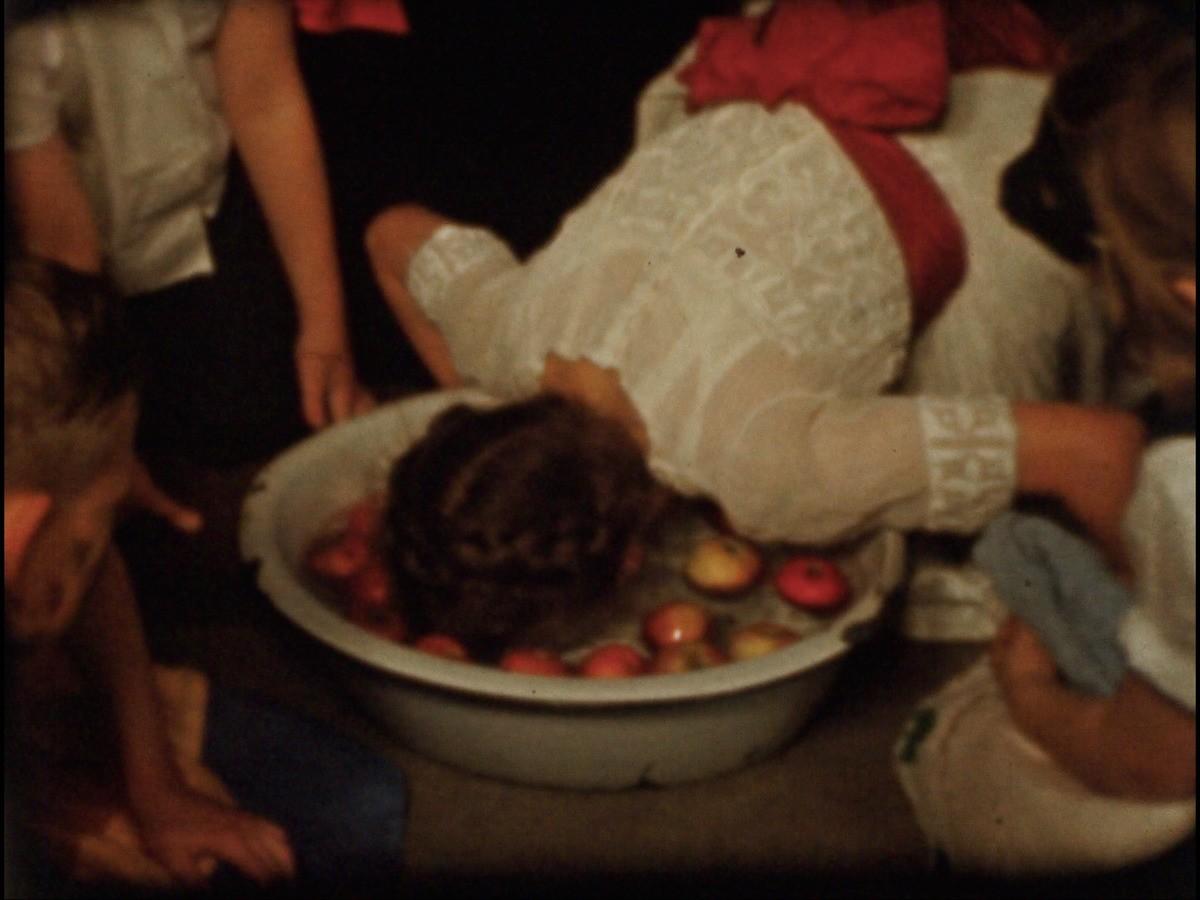
Rick Prelinger, Home movies of the home: Bobbing for Apples (1951), 2020. Film still courtesy of Prelinger Archives.
An Amnesia of Abundance
Home movies have recently moved from the fringes of culture closer to the centre, but that doesn’t mean their cultural status is secure. They are always vulnerable to the same things that traditionally threaten the historic record: fire, flood, heat, humidity, and, hardest of all to defend against, indifference. The digital shift imposed amnesia onto culture; refreshing is forgetting, and the “new” almost always crowds out the “old.” But let’s not blame digitality for everything. Amnesia is a safety valve activated, among other causes, by trauma and overstimulation, and it is probably as old as the human brain itself. Whether with physical or digital media, we need to accept that, while every film may be precious, we will also need to come to terms with loss. Loss is a tragedy, and intentionally causing the loss of culture and history is criminal. But loss is inevitable and can also be formative. As absence helps us appreciate presence, value and specialness can arise through loss. Many of the histories that came to prominence in the 1960s and 1970s—women’s history, labour history, the histories of underrepresented communities, and social histories of everyday life—emerged precisely because of the feeling that they were lost, stolen, or suppressed. The perception (whether correct or incorrect) of loss motivated attempts to rediscover what we thought no longer existed. Loss is unfortunate, but we can leverage it to make more of what we can find. Absence speaks as loudly in archives as it does in home movies. Archives don’t only hold records—they’re also collections of gaps, silences, and erasures. Silences speak loudly, testifying to past and present disrespect and indifference, failures to collect and preserve, and the effects of power differentials on the archives itself. It is more useful to think of archival absence as coequal with presence, and be attentive to what absence might mean and what we can learn from it. The home movies that have been lost are as meaningful as those we can still watch. We cannot, and should not, aspire to collect everything.
But what if we could? What if we could digitize and somehow preserve every home movie and every personal document? We are approaching the technical capability to do so, though it is unlikely we will soon be living in an environment that is kind to fragile bits. In such a situation, we could in theory play everything back, but would that constitute memory? Do we remember every fact and idea in the millions of books that sit on library shelves? I am tempted to suggest that infinite memory brings to bear a new kind of amnesia: an amnesia of abundance. What we hope to remember is at risk of being lost in an infinite archive.
Troubling the Archives
Home movies are the latchkey children of moving-image archives, recognized as kin but largely left to fend for themselves. They don’t behave like other cultural materials, and we can’t treat them the same way. Archives that have focused on records of the state, institutions, and businesses or on works of artistic and historical importance aren’t well equipped to handle large numbers of these highly granular records of daily life, especially when they’re physically fragile and raise complex issues of privacy and respect for their subjects. Canonical strategies of cataloguing, description, and preservation fly out the window when you face infinity and it’s poorly shot and labelled. Collecting home movies forces archives, to borrow a famous line from Bertolt Brecht, “to choose between being human and having good taste.” Home movies require a new curatorial attitude that can stare infinity in the face and smile.
Home movies trouble the archives. The relatively recent emergence of home movies has challenged the courageous archives that try to house them. At first they treated home movies in the traditional manner: enclosing them in spiderwebs of copyright, caution, and concern; treating them as orchids that needed to be preserved and could not themselves be touched by the untrained. But then emerging archivists began to celebrate home movies with screenings, breaking the taboo of screening original films that had not yet been preserved. They recognized that to show films was—at least, in the consciousnesses of the viewers—to preserve them, while being at the same time a step forward in the inevitable process of slow destruction, and they embraced this inevitability. We cannot repeat that enough: to show film is to slowly destroy it. The lifespan of film, like that of humans, is variable but finite. Home movies will not last forever. They need attention; they need to be unrolled and shown if they are to survive, just as your dog needs to go on a walk, but every projection is a life-lessening moment.
Emerging archivists also espoused the principle that not all films should be in film archives, but rather that home movies should stay with the people who made them. Support for community and regional archives has grown in recent years, and there are as many kinds of community archives as there are communities that share some commonalities. They don’t collect to stockpile trophies but to document history, experience, and consciousness in a particular community. They typically define their collection policy based on community needs and interests, and quite often are led by community members rather than by professional archivists or librarians. The significance of the community archives movement is about far more than simply decentralizing collecting; it’s also about building collections that are not just storehouses of history but venues where people convene to make historical interventions, to inject the record of the past into the present so as to affect the future. Community archives are still learning what they can be, but they may be the best homes for home movies. Perhaps much of the home-movie diaspora—the mass of personal film held in basements, private collections, and thrift stores, and lying uncatalogued and unseen in large institutions—will one day come home to the places where it was filmed and find an enthusiastic welcome.
Movies on the White Wall
What, then, does it mean to show home movies in a museum?
Home movies belong with the families and communities that created them, but they also resonate within the museum. Putting a home movie on a screen (whether large or small) rips it out of whatever we might imagine to be its original context, but it also signals that the film is worthy of observation, perhaps even urgent to observe. If (and I simplify here) home movies functioned first as visual diaries, and later home video became a means by which we perform relationships, restoring home movies to the centre of our attention is a way of putting on the brakes, slowing down from frenzied image-making and seeing differently. Doing so also offers us the chance to see home movies not only as retrospective but predictive—as triggers for imagining different futures, new geographies, different contours of human connection, and new arrangements of society.
Thinking about the continuum of personal record-keeping leads us to question bifurcated tracks of expression. Why do we record the happenings of our lives in both personal media and in what we explicitly call art? Could we reconsider, or at least trouble, that distinction? Can we dissolve the divide between quotidian, even disposable media and art, which we imagine as expression made for the ages? Can we look beyond labels and inherited ideas of value? Can we make peace with the often-problematic record left by our ancestors and consider what sort of useful and pleasurable record we wish to leave for those who come after us? By looking at how people from different times and different communities have recorded themselves, could we slow down and rethink how we might want to perform our lives and record ourselves in an age of continual crisis and uncertainty?
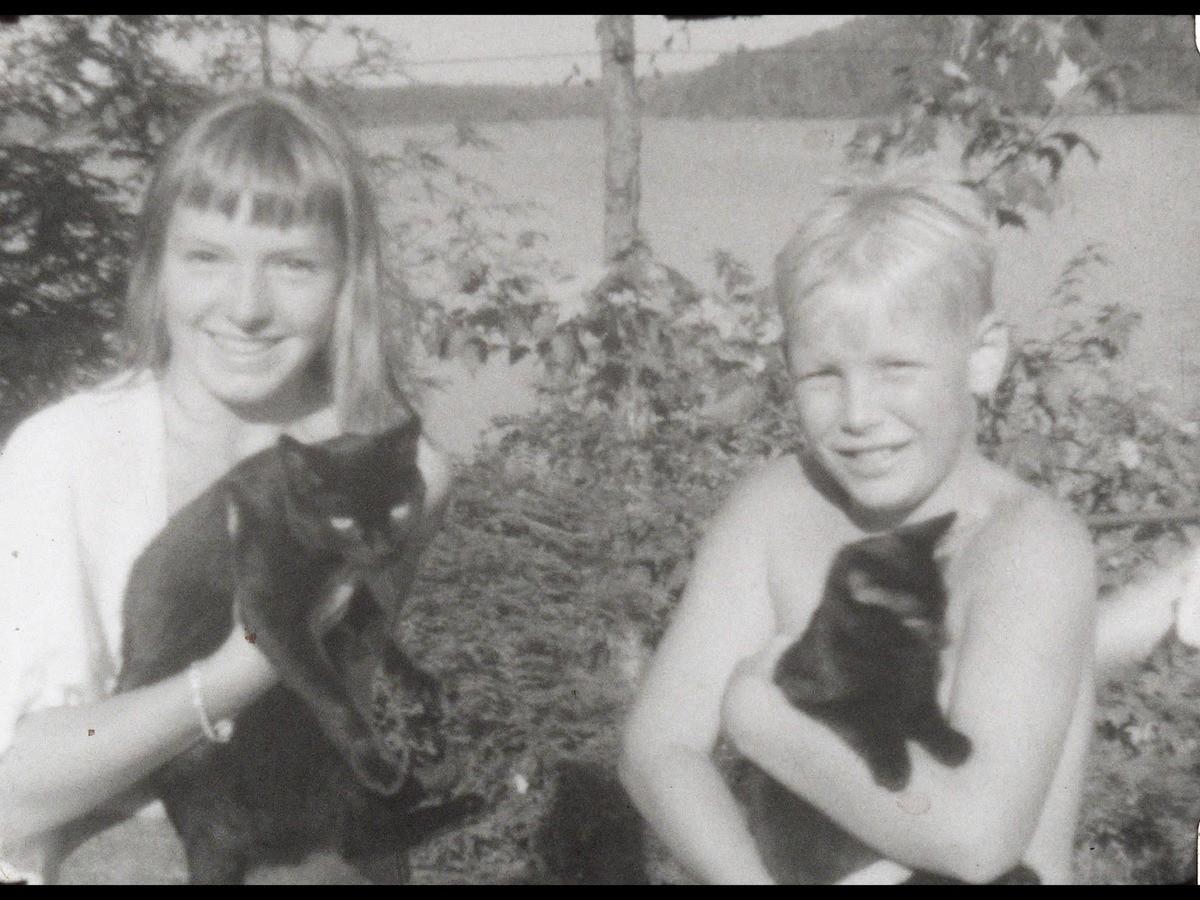
Rick Prelinger, Home movies of the home: Children Holding Black Cats (1944), 2020. Film still courtesy of Prelinger Archives.
—
I thank all of the individuals and families, whether known or unknown, who have contributed material to enrich the home movie archives. I especially thank Emily Chao, Skip Elsheimer, Adrianne Finelli, Brewster Kahle and Internet Archive, Lloyd Molina IV, the Molina family and the Salazar family, Steve Polta, the members of San Francisco Participatory Archives Group, Yvonne Wang and David Wiegleb. I am deeply indebted to the Center for Home Movies and the many who serve, inspire and participate in the home movie-focused archival community. Scanning was made possible in part through the Arts Research Institute of the Division of the Arts and the Academic Senate Committee on Research, both at UC Santa Cruz, and by a generous in-kind grant from Internet Archive. Finally, I thank the entire AGO team, especially Jim Shedden for his vision and generosity, as well as his co-curator, Alexa Greist, and the team of Nives Hajdin, Robyn Lew, Sarah Liss, Katarina Veljovic, and Kathryn Yuen. None of this work would have been possible without the unconditional support and incalculable contributions of Megan Shaw Prelinger, my partner in the archives and in life. We live a series of collaborations and adventures, and among our favourites are our scanning days, when I assemble film into scannable reels and she works the magic tools of digitization that transmute these precious and often inconvenient objects into digital life. The archives are an embodiment of our partnership. I wish to acknowledge that my work takes place on the occupied traditional lands of the Yelamu Ohlone people, including the villages known as Petlenuc, Sitlintac, Chutchui, Amuctac, Tubsinte and Ompuromo, whose sites are within the boundaries of today’s city of San Francisco. The Ohlone people are still present throughout the city and Peninsula of San Francisco and we live among them today.

